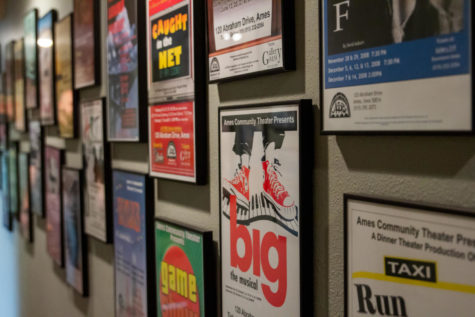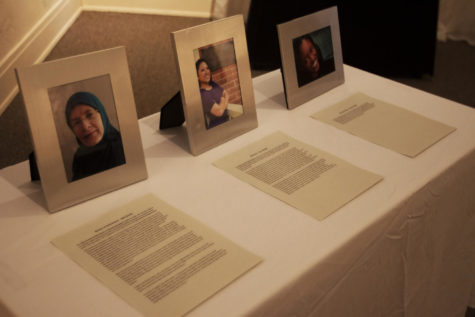Green Dot in the classroom
Luke McDonell/Iowa State Daily
Students had the chance to participate in many different activities at the Green Dot Launch event.
Trigger warning: This article discusses topics such as violence, sexual assault and stalking. For resources regarding these topics, go to the Iowa State Green Dot website, call ISU police at (515) 294-4428 or dial 911 in an emergency.
This article is the second of a promotional series by the Iowa State Daily on Green Dot.
Green Dot, a program aimed at preventing power-based personal violence, is on the rise at Iowa State as community members spread the message through a variety of campus-related interactions and activities.
According to their website, a green dot is any choice, behavior, word or attitude that promotes safety for everyone and communicates utter intolerance for power-based personal violence. Students and faculty across the university are working to spread awareness of the program and encourage more students to adopt a “Green Dot” mindset.
Associate teaching professor in Women and Gender Studies Alissa Stoehr said she works to spread Green Dot awareness by incorporating Green Dot elements into applicable portions of her classes.
“I talk about it in all my classes,” Stoehr said. “I have it as part of my syllabus. You know when you go on the first day of class, you go through the syllabus and we have campus resources. I always have it in under that.”
Stoehr said she also talks about Green Dot whenever she touches on related issues during her women and gender studies classes. While typically Stoehr sticks to educating students on Green Dot, she is also willing to help educate faculty and staff on how to be involved with Green Dot.
“After each lecture, the last slide is about campus resources, so I talk about Green Dot through that,” Stoehr said. “So really talking about it, not just throwing it into the syllabus, but actually talking about what it is and talking about some of those components throughout the semester.”
Stoehr said that touching on Green Dot in class isn’t necessarily Green Dot training, but by incorporating bits and pieces of Green Dot resources, she is exposing students to the program and hopefully pushing them towards becoming a deterrent for power-based personal violence.
“I’m always talking about it; I’m always promoting it,” Stoehr said. “For Destination Iowa State, I had never done Green Dot through there, so a whole bunch of us got together and did Green Dot trainings for all the new incoming students.”
Stoehr said that previous sexual assault trainings and prevention programs, while always backed with good intents, have not been as effective or well received as Green Dot.
“I remember when it was Sexual Assault Prevention Month, and we still have those types of things, but when we would do training, it’s like ‘don’t walk by yourself, don’t talk to strangers, don’t leave your drink unattended’ and all those things,” Stoehr said. “Which you should do, but the language is problematic. “
By focusing on the perpetrators and the victims of power-based personal violence, trainings can be perceived as victim-blaming and can also exclude others.
Stoehr said that oftentimes she would receive pushback from male students who felt they were being grouped in with typical perpetrators of power-based personal violence.
“When Green Dot came about and really focused on bystander intervention, that’s where I was like ‘oh, I like this.’ It’s not victim blaming. It’s not, you know, males are bad, stop abusing females,” Stoehr said. “It was what can you do to not only protect yourself but also to protect the people around you.”
Stoehr said that much of Green Dot training has to do with recognizing signs of power-based personal violence and using distractions to diffuse the situation.
“For some people, that’s a little scary, too, because they don’t want to be part of the attack if something’s going on,” Stoehr said. “So giving people options and seeing what they’re most comfortable with, I think, is one of the reasons why Green Dot is so effective.”
While professors like Stoehr try to push Green Dot in academic settings, others learn of the program through more social facets.
Emma Boutwell, a freshman with a pre-business major, said she first learned about Green Dot through her sorority.
“I think that Green Dot encourages everyone to be more safe,” Boutwell said. “Green Dot has resources that you can use to help make campus a better and safer place. I think about good resources, like the apps you can download. I haven’t really seen that much in my classroom; it’s more outside of the classroom.”
Others learn about Green Dot simply through the variety of individuals working to raise awareness of the program. Haniyeh Fekrmandi, a graduate student in computer science, said she first learned of Green Dot when she saw people handing out flyers in front of Parks Library.
“I think it’s really important at the university, and this is very useful,” Fekrmandi said. “It should be established, and it should be advertised so everybody knows about it.”
Kasch Petersen, a freshman in engineering, said he first learned about Green Dot at Destination Iowa State.
“I do think there’s enough people on campus that will want to make a change if something was happening, or if they saw something happening, they’d be willing to assist,” Petersen said. “It’s prevailing, but I haven’t seen it happen, so I can’t say for sure.”
While he hasn’t experienced power-based personal violence himself, Petersen did say his general experience at Iowa State has been quite accommodating. Peterson said that the majority of his professors and peers have been willing to listen and provide assistance where they can.
“I definitely feel like there’s that kind of community; we would want to help and support each other if something were happening,” Petersen said. “Obviously, a few bad apples can kind of ruin the whole bunch, but there’s an overwhelming majority.”
Paige Evans, a freshman in animal science, also said she learned about Green Dot from Destination Iowa State. While the Destination Iowa State training did introduce Evans to the program, she said that she could use more in-depth knowledge on the subject.
“I know there’s a lot of options for students if they’re experiencing any issues,” Evans said. “There’s all these organizations to go to and help them with anything that they need, and I feel like the Green Dot organization is pretty good with that, too.”
For information on Green Dot Action Month taking place every October, visit the Green Dot Action Month website. For a comprehensive list of Green Dot resources, visit the Green Dot website.
Your donation will support the student journalists of the Iowa State Daily. Your contribution will allow us to purchase equipment, send our student journalists to conferences and off-set their cost of living so they can continue to do best-in-the-nation work at the Iowa State Daily.







